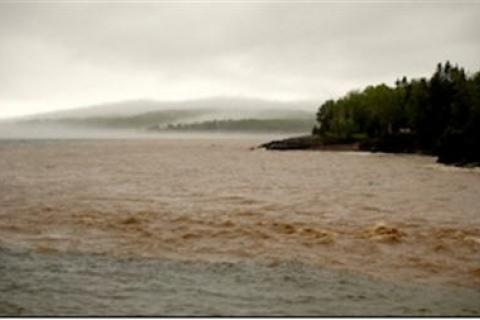
Too many times, fishermen go to the lake and find the lake covered in rolling waves or at least a strong wind that makes it uncomfortable to be on the water. They pack up their gear and head back home to watch fishing shows on TV and mumble and grumble all day long. (This is not to say that fishing shows make you mumble and grumble.)
This is really ridiculous. They are walking away from some very good fishing -- I mean, some really GOOD fishing. This is more so true in the summer months when the oxygen in the water is fluctuating from low to lower. This causes the forage to move to shallow water to get a little “breathing room,” so to speak. Where they go, so goes the largemouth bass and any other game fish that are popular.
So, what is the deal? The wind creates wave action. When the waves break along the shoreline, it creates an oxygenating effect and fills the shallow water with much-needed oxygen, cooling the water. Forage is attracted to the oxygenated water.
Plus, the wave action creates a muddy water effect and the largemouth are more comfortable being in water where they are not so visible to everything in the area. This security causes the bass to have a huge “strike zone” and to feed like there is no tomorrow.
The “strike zone” is how far a bass will travel to strike forage or an artificial fishing lure. Sometimes this zone is only a few feet -- in the winter months, maybe even less -- but in the night time or muddy-water conditions, they may travel as far as 12 to 15 feet.
I am sure most fishermen have seen a wake going across the surface toward their lure. That is a bass exercising his strike zone selection. I’ve seen bass in demonstration tanks travel at least 10 feet in bright-light conditions. That’s a long way. That’s also a hungry bass. So, you can imagine how big the strike zone might be in the spring time when the bass are really feeding heavily or on a hot summer day when it has been hot and calm for days, and then a windy day comes along … food is the topic of the day, and the windy banks make for a smorgasbord for them.
To fish these waters effectively, one needs to be in a position where he can cast into the wind. This means positioning your boat in shallow water and casting out. This is tricky, so be sure to stay in a safe depth and make sure that the trolling motor is strong enough to navigate out of the wave action. This is very important. I’ve seen guys get stuck on a bank and can’t get off of it because of the wind. The waves pound the boat to pieces.
Sometimes the only thing to do is to wade the boat out of the shallows on foot. And that is really tricky. If you use your big motor, you risk the prop or skeg getting damaged.
The lure of choice is a crankbait. Some guys might argue this point with me, but you are trying to present an imitation of the forage, and usually the forage is shad or minnows. Look around in the water alongside the boat and make a call.
Once the lure choice is made, reflect on the basic principles of bait casting. Keep the handles of the reel pointed up and cast “up” and not out. This action actually causes the lure to travel straight out. Doesn’t sound right, I know, but its true. Use light line, which backlashes not so easy due to the lack of memory, or use braided line. If the reel handles are not pointed up, the reel will backlash. With the handles up, the line falls off the spool as opposed to “unwinding” off the spool.
The best spots to fish are usually the flats left or right of a point. This is pretty specific, but don’t waste half a day looking for such structure. The mouths of creeks are good, and my favorite is over a weed bed area. Weeds are great for holding forage and for feeding.
Understand that not every windy bank will hold biting largemouths. Use the basics of largemouth movement to figure out a good spot. A good rule of thumb would be any bank that is close to deeper water or heavy cover. Such a bank will hold some nice numbers and probably a good-size bass or two.
Lure options are top waters and spinnerbaits. I still prefer a crankbait. But the main thing is to keep the bait in the water as long as possible. A lot of bites will come right at boat side. Watch your position toward the bank and any trouble, and wear your life vest at all times … just in case you fall out from the rough ride.
I know that a nice, quiet cove or pocket with still waters out of the wind is very relaxing, but these are not very productive areas. To have a nice relaxing day, go to the pocket. To catch some fish, hit those windy banks.
Good fishing to ya!
by Jimmy Houston
- 31101 views

